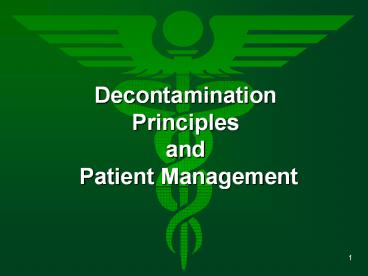Decontamination Principles and Patient Management PowerPoint PPT Presentation
1 / 24
Title: Decontamination Principles and Patient Management
1
Decontamination Principlesand Patient
Management
2
Module Objectives
- Define decontamination
- Describe the differences between non-ambulatory
and ambulatory decontamination - Discuss procedures for the wet and dry
decontamination - Discuss the decontamination planning process /
patient management - Identify regulatory compliance issues
3
What is Decontamination?
The process of removing or neutralizing surface
contaminants that have accumulated on personnel
and equipment.
4
Why Decontaminate?
- Emergency responders should ONLY decon to
- Control gross contamination
- Facilitate police measures
- Provide medical care
- Including psychological support
5
Decontamination
- Three methods
- Mechanical, chemical, physical
- Types of Decontamination
- Patient decontamination
- Personnel decontamination
- Personal decontamination
- Equipment decontamination
6
Decontamination
- Level of Protection
- - Respiratory
- - Protective clothing
- Isolation Zones
- Hospital Decontamination
- Decontamination Planning Process
7
Selection of Appropriate PPE
- Personal protective equipment (PPE) selection
shall be based on an evaluation of the
performance characteristics of the PPE relative
to the requirements and limitations of the site,
the task-specific conditions and duration, and
the hazards and potential hazards identified at
the site (CFR 29, 1910.120)
8
Levels of Protection
Bunker Gear ?
Greater Hazard
Level A
Level B
Level C
Level D
Higher Burden
9
Isolation Zones
COMMAND POST
ACCESS CORRIDOR
INCIDENT SITE
DECONTAMINATION CORRIDOR
HOT
SAFE REFUGE AREA
WARM
COLD
WIND DIRECTION
10
Hospital Decontamination
- Patient population
- Selection of appropriate PPE
- Decontamination process
- Medical care at the incident site and
decontamination areas - EPA will waive requirements for run off
collection in an emergency situation
11
Patient Population
- Self-selected population
- Ambulatory minimally symptomatic or worried well
- Sick patients brought in via EMS
- Survived without PPE
- Can be considered not immediately dangerous to
life and health (IDLH)?
12
Personnel
- Who gets trained?
- - Awareness
- - Operations
- Availability
- Operational Control
- Emergency Department Staff
- Other Identified Hospital Staff
13
Decontamination Site Selection
- Outside!
- Level impermeable surfaced area
- Up wind
- Water supply/collection
- Illuminated
- Ingress and Egress routes
14
Hospital Decontamination
Triage
Immediate Treatment
Arrival Point
Dry Decon
Wet Non-Ambulatory
Wet Ambulatory
Hospital Secondary Treatment Facility
15
Arrival Point
- Purpose
- Initial reception for potentially contaminated
patients - Patient checked for contamination
- Location
- Close to triage area
- Staffing
- Personnel in Level C?
16
Decontamination Areas
- Personnel
- Self vs Buddy Assisted
- Hasty vs. Thorough
- Standard vs. Field-Expedient
- Casualty
- Ambulatory vs. Non-Ambulatory
- Spot vs. Whole-body
- Wound
- Mechanical vs. Chemical
17
Dry Decontamination
- Vapor or no exposure
- Removal of clothing
- Modesty concerns
- Tracking of Valuables
- Requires large amounts of disposable clothing
- Clothing disposition
18
Address Psychological Effects
- Consider the following to
- address public fears after
- decon
- Explain risks (provide information sheet)
- Offer careful but rapidmedical assistance
- Avoid unnecessaryisolation or quarantine
- Treat anxiety inunexposed personswho are
experiencing somatic symptoms
- Responses following an event may include
- Horror
- Anger
- Panic
- Paranoia
- Fear of contagion
- Demoralization
- Social isolation
- Unrealistic concernsabout infection
19
CISM Must have a plan for Critical Incident
Stress Management
- Employees
- Volunteers
- Patients
- Worried well
20
One contaminated patient may close your Emergency
Department and/or Hospital
21
Decontamination Planning Process
22
Decontamination Planning
- Integral part of planning for emergency response
- Will reduce potential for injury and save lives
during emergency response phase following
significant agent release - Decon of people must begin immediately, with
implementation of protective actions - Addresses priorities and procedures for decon
planning
23
Decon Planning Required by
- JACHO
- AOHA
- OSHA
- State OSHA
- DEQ
24
Decon Plan Required
- Describe agencies to be responsible
- Describe resources to be available
- Describe procedures to be followed to deal with
agent-contaminated people and animals that
provide critical support to humans - Plan should emphasize self and buddy
decontamination
25
Planning Issues
- Site location, layout, preparation
- Security and Communications
- Logistical support
- Equipment (unit level)
- Evacuation assets
- Personnel issues
- Training
- Manpower
26
Planning Issues
- Cost effective
- Mass Casualty
- Rapid set-up
- Patient privacy
- Protection of property
- Training
27
Where do we go from here?
- Reassess our approach to the Mass Casualty
Incident - Hospitals Develop Internal Plans for
Decontamination - Reassess the regulations concerning PPE
- Regional Planning
- Pre-Planning
- Advance Training Programs (ADLS)
28
Personnel Training Requirements
- Patient transport
- Decontamination
- Non-Ambulatory, Ambulatory, Personnel
- Detection and monitoring
- Hazard avoidance (for all personnel)
- Personal protection
- Work / rest cycles
- Rehydration
29
Summary
- Physical removal is BEST decon
- Must plan for patient decon at all aspects of
care - Decon process is resource intensive and must be
planned and practiced in advanced - Identify and train personnel early
- Learn benefits of coordination with medical
assets in your hospital and region - Prior Planning Prevents Poor Performance

